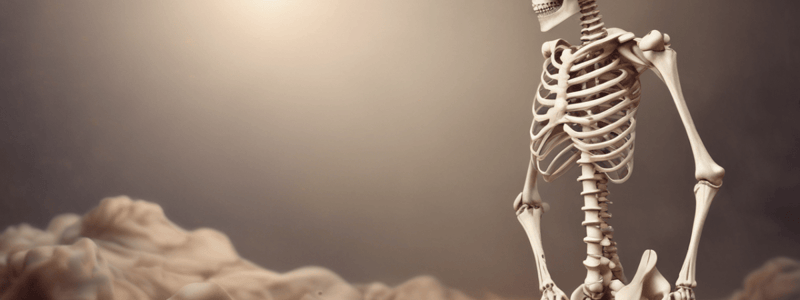Podcast
Questions and Answers
What is the main characteristic of osteoporosis?
What is the main characteristic of osteoporosis?
- Bone resorption outpacing bone deposition (correct)
- Deceleration of bone resorption
- Complete halt of bone remodeling
- Acceleration of bone deposition
Which of the following is a risk factor for osteoporosis?
Which of the following is a risk factor for osteoporosis?
- High etoh intake (correct)
- High protein intake
- Regular exercise
- Adequate vitamin D and calcium in diet
What is the most common treatment for osteoporosis?
What is the most common treatment for osteoporosis?
- Hormone Replacement Therapy (HRT)
- Calcitonin
- Selective Estrogen Receptor Modulators (SERM’s)
- Bisphosphonates (correct)
What is the prototype of Bisphosphonates?
What is the prototype of Bisphosphonates?
What is the adverse effect of Bisphosphonates?
What is the adverse effect of Bisphosphonates?
What is the condition characterized by softening of bones due to demineralization?
What is the condition characterized by softening of bones due to demineralization?
What is the most common cause of osteomalacia?
What is the most common cause of osteomalacia?
What is the condition that occurs in children due to demineralization of bones?
What is the condition that occurs in children due to demineralization of bones?
What is the most common joint disease?
What is the most common joint disease?
What is the primary mechanism of action of Uricosurics in treating Gout?
What is the primary mechanism of action of Uricosurics in treating Gout?
What is the adverse effect of Methotrexate that requires monitoring?
What is the adverse effect of Methotrexate that requires monitoring?
What is the primary treatment goal of Disease Modifying Antirheumatic Drugs (DMARD's)?
What is the primary treatment goal of Disease Modifying Antirheumatic Drugs (DMARD's)?
What is the primary indication for Hydroxychloroquine Sulfate (Plaquenil)?
What is the primary indication for Hydroxychloroquine Sulfate (Plaquenil)?
What is the primary mechanism of action of Xanthine Oxidase Inhibitors in treating Gout?
What is the primary mechanism of action of Xanthine Oxidase Inhibitors in treating Gout?
What is the contraindication for using Tumor Necrosis Factor Blocker (TNF Blocker)?
What is the contraindication for using Tumor Necrosis Factor Blocker (TNF Blocker)?
What is the primary treatment for severe pain and inflammation in Gout?
What is the primary treatment for severe pain and inflammation in Gout?
Flashcards are hidden until you start studying
Study Notes
Bone Resorption and Osteoporosis
- Bone resorption outpaces bone deposition, increasing the risk of osteoporosis.
- Risk factors: menopause, high ethanol intake, anorexia, tobacco, inactivity, low vitamin D or calcium in diet, and long-term use of proton pump inhibitors (PPIs).
- Identification of best course of treatment: bone density scan (DEXA).
Bisphosphonates
- Most common treatment for osteoporosis.
- Block bone resorption by inhibiting osteoclast activity to increase bone density.
- Prototype: Alendronate (Fosamax).
- Administration: take on an empty stomach with a full glass of plain water, at least 30 minutes before first food or beverage of the day.
- Adverse effects: dysphagia, esophageal irritation, and interference with antacids.
Selective Estrogen Receptor Modulators (SERMs)
- Used for postmenopausal osteoporosis.
- Prototype: Raloxifene (Evista).
- Contraindications: patients with a history of venous thromboembolism.
- Adverse effects: menopausal symptoms like hot flashes and night sweats.
Other Treatments
- Calcitonin: decreases bone resorption by inhibiting osteoclast activity.
- Oral calcium modifiers: miscellaneous treatment for osteoporosis.
- Monoclonal antibody denosumab (Prolia): miscellaneous treatment for osteoporosis.
- Human PTH teriparatide: miscellaneous treatment for osteoporosis.
Rickets and Osteomalacia
- Softening of bones due to demineralization.
- Most common cause: deficiency of vitamin D and calcium in diet.
- Most prevalent in older adults, premature infants, and strict vegans or vegetarians.
- If it occurs in children, it is called rickets.
Osteoarthritis
- Chronic condition characterized by accelerated remodeling of the skeleton.
- Process of bone resorption and deposition occur simultaneously at a high rate.
- Signs and symptoms: localized pain and stiffness, joint and bone enlargement, and reduced range of motion.
- Treatment: Acetaminophen, NSAIDs, topical medications (Capsaicin cream), and Sodium Hyaluronate (Hyalgan) injections into joints.
Rheumatoid Arthritis
- Systemic autoimmune disorder; autoantibodies activate an inflammatory response.
- Treatment: NSAIDs, corticosteroids, Tumor Necrosis Factor Blocker (TNF Blocker), and Disease Modifying Antirheumatic Drugs (DMARDs).
- Adverse effects: increased risk of infections, liver problems, stomach pain, hair loss, and ocular toxicity.
Gout
- Form of acute arthritis caused by a buildup of uric acid crystals in joints and tissues.
- Treatment: NSAIDs, corticosteroids, and prophylactic therapy (Uricosurics and Xanthine Oxidase Inhibitors).
- Prophylactic therapy: increase excretion of uric acid or inhibit formation of uric acid.
- Prototype: Allopurinol.
Studying That Suits You
Use AI to generate personalized quizzes and flashcards to suit your learning preferences.




